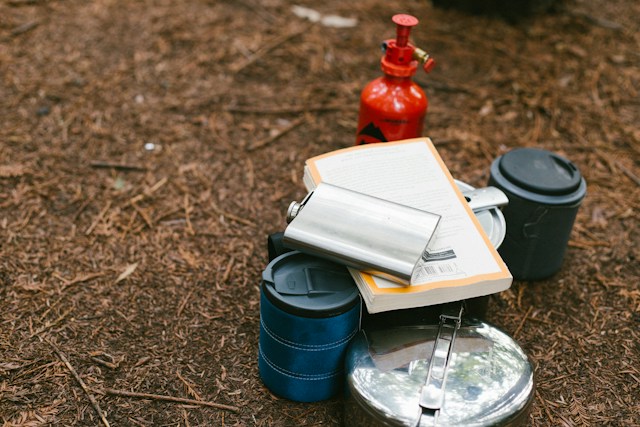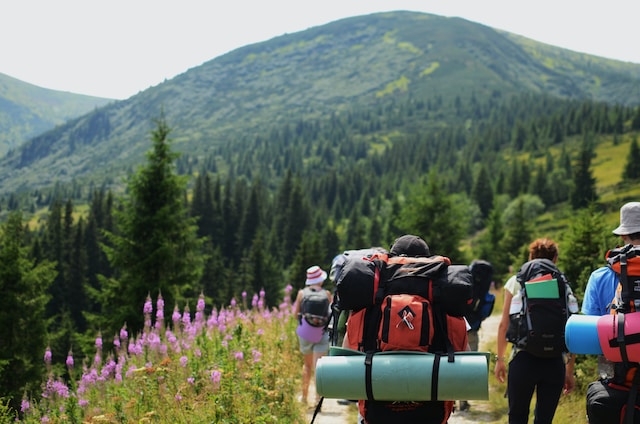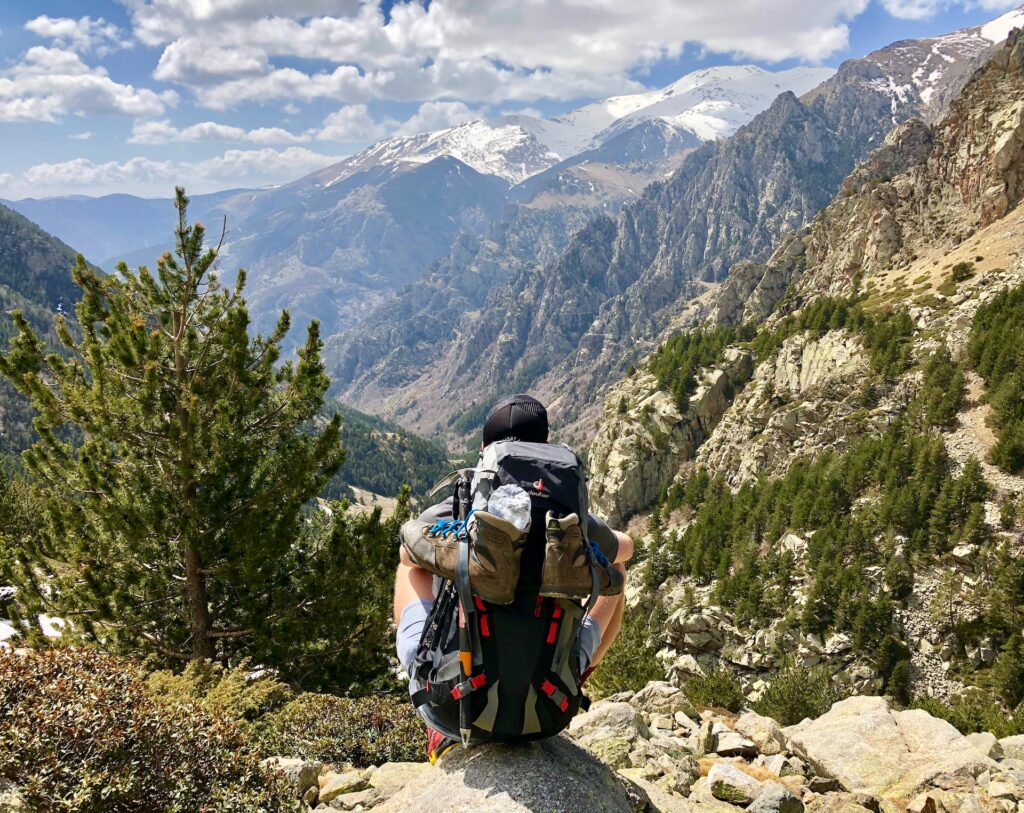Deciding what to pack for your next hike is crucial, but maybe even more important is figuring out what NOT to take on a hike. The reason is that you will definitely be feeling every extra gram you unnecessarily packed when climbing that hill three hours into your hike! You probably thought to yourself while packing: “I’m not sure, but maybe I’m gonna need that”. Big mistake!
Most beginners pack too much for a hike because they think it’s better be safe than sorry. While this is a prudent guideline in many (most?) situations, you have to be careful when deciding what to stuff your backpack with. Experienced hikers recognize the value of packing smart and leaving behind unnecessary gear. They realize that packing too much can easily transform an adventure into a burden!
In this post, I’ll share some of the common items that often find their way into hiking backpacks, but should be left at home.
What Not To Bring On a Hike?
There’s an acronym that is very popular in the agile software development community. That acronym is “YAGNI” which stands for: You Ain’t Gonna Need It. Software teams use this mantra to avoid complicating their software with features and capabilities they think they might need in the future. Instead, YAGNI encourages them to focus on developing only the business requirements they know will add value to their software TODAY.
Similarly, when reasoning about what and what not to take on a hike, we should always think about whether we truly need an item for a particular hike. The general rule you should follow is that if something is “nice to have”, then it should stay at home. Besides the 10 hiking essentials, only pack what you need and nothing else.
Excessive or Inappropriate Gear
Consider the terrain and weather conditions to determine the appropriate gear to pack. For example, if you know the trail is almost entirely flat, then do you really need to bring trekking poles? Probably not.
Similarly, think about the territory you’re hiking into and consider whether you really need that axe or shovel. For the majority of cases, you’re unlikely going to use them. They’re just adding unnecessary weight to your backpack. A simple and small multi-tool set or a Swiss army knife will probably have more functions than you’ll need.
Extensive First-Aid Kit
A first-aid kit is one of those things that should be in every outdoor adventurer’s backpack. However, that does not mean you should buy the most extensive first-aid kit and pack it for your hike. Instead, I select only the essential items that could help me deal with common trail injuries and leave the rest of the kit at home. Think things like bandages, duct tape, alcohol wipes, an antiseptic and pain killers. If you or one of your companions get seriously injured, then you’d be better served calling for emergency services.

Unnecessary Electronics
There’s nothing that pisses me off on a hike than someone blasting their portable speakers. First off, how could this person be so inconsiderate to their fellow hikers or even the animals living in the wild? Second, those speakers are often heavy and bulky, so why not use earphones instead?
Other examples of electronics you shouldn’t be taking with you on a hike include laptops, tablets or e-readers (ex: Kindle). These are heavy and you are likely not going to get the chance to use them anyway. Moreover, I do not know about you but a hike is an opportunity to disconnect and immerse myself in nature.
Finally, even a GPS device might be excessive and an unjustified item to pack in many cases. If you’re going hiking in well marked trails, then a navigation app on your phone should be more than enough. Also, although I consider a portable charger as an “almost essential”, if you know you’ll be back home in 2-4 hours then you should probably leave it behind.
A Big Kitchen
You’re out in the wilderness where most people assume will be “roughing it”, do you really think you need that full set of cookware and utensils? I’m pretty sure you won’t be using it all. And, I predict having to unpack and re-pack it after every meal will be more of a hassle than a convenience.
Just bring a single cooking pot that you can also eat from, a spork and a backpacking stove if you’re very keen on cooking in the wild. Alternatively, you could just pack food items that do not require any cooking. Some examples are energy/protein bars, nuts and nut butters, dried fruits, and any ready-made meals that do not need refrigeration.
Valuables
This goes without saying but it’s important to remind you not to pack anything you cannot afford to lose. One obvious example is jewellery which should stay home but folks often bring on a hiking trip for some odd reason.
Luxury Items
Your back will feel so much better when you realize it’s not sitting on the ground or a rock that’s giving you back-pain. But rather the extra weight of carrying folding chairs and other unnecessary items that will supposedly help you get comfortable. I recommend you accept the fact that you will never be 100% comfortable in the wild (and you’re not supposed to!)
So, instead of a bulky folding chair, just pack a folding foam sit pad or plastic bags to sit on. Also, you do not really need a full-sized pillow that takes up too much space in your backpack. Opt for a compact backpacking pillow instead, or maybe even use your backpack or your jacket as an improvised pillow.

Books
I enjoy reading a lot. But I’m certainly not going to burden my back with the weight of a bulky physical book when I go backpacking. Instead, I read off my phone and it works perfectly fine for me. However, if you’re one of those who can’t get over the feeling of flipping papers when they read, either postpone your reading for another time, or pack a small and thin book. Trust me, every gram counts especially on challenging terrain in the backcountry.
Heavy or Excessive Clothing
I feel bad every time I see someone hiking in jeans pants and/or cotton clothing. Cotton absorbs and retains moisture which will leave you wet throughout your hike. The worst part is that it loses any ability to insulate when it gets wet which is bad in both hot and especially cold weather. Instead, always go for synthetic blends or merino wool based hiking wear. They’re lightweight, insulating, moisture wicking and quick drying.
On a different note, packing extra clothes is one of the essentials we recommend. But, that does not mean emptying your closet into your backpack! If you’re backpacking, you do NOT need a different outfit for each day of hiking! A single outfit of good quality material that is usually odor resistant should last you a few days. It’s reasonable to pack a few extra pieces if you’re expecting weather conditions to change, but don’t go overboard. Also, you do not need more than a pair of sturdy hiking shoes or boots. If you’re crossing a body of water, either take your shoes off or bring a pair of light flip-flops.
Too Much Food & Water
Similar to excess clothes, we also encourage you to bring more food and water than you think you need. But do it within reason! If you’re going on a 2 days hike, bring 3 days worth of food. If you’re hiking for 3 days, pack enough for 4 days. You get the idea. Most novice hikers pack enough to last them a whole week on their first weekend backpacking trip. That’s just excessive and it’ll weigh you down and make you miserable on the trail.
The same goes for water. It’s important to stay hydrated in the wild, but carrying a lot more than you need can get REALLY heavy. One thing to consider is a water filter when you know there will be water sources available on or near the trail. This can easily shave a few liters off your back, which is quiet significant! That’s exactly why I love my Sawyer Micro Squeeze.
Heavy Photography Gear
I left this for last because it’s what I struggle with the most. I’m enjoy wildlife photography and carry a Sony A7RV with the almost 2.25kg Sony 200-600mm lens. In addition, I pack a smaller 28-200mm zoom and a few other accessories in my backpack. Yes, I know what you’re thinking: that must be super heavy! And you are right.
On a recent hiking trip in Sri Lanka, I left my photography gear in the guesthouse because I knew I wasn’t going to need it. When we returned back, I shared with my wife how much more I enjoyed the hike because, in addition to the MUCH lighter load on my back, I got the chance to completely focus on the hiking, rather than be on the lookout for any birds or wildlife.
I’m not suggesting you always leave your camera behind, but instead to think carefully of what photo-gear to pack. I’m pretty sure there’s one lens you use for at least 80% of your shots. So maybe grab that and leave the rest at home. Also, another thing I’ll be doing moving forward is to separate my photography outings from my usual hiking. Like I said above, I enjoyed the hike a lot more when I did not have to worry about the photography at the same time. And I promise you would too!

Final thoughts on what not to take on a hike
I know it can be tempting to pack everything you feel might be useful to you on the trail. But I advise you to follow a “less is more” mentality when deciding what to bring on a hike. The lighter load is going to reduce back and knee pain, and help make your whole hiking experience a lot more enjoyable.
Just pack the essentials and only add the items which are critically important for the trip’s terrain and/or weather conditions. Everything else shall and should be left behind.
Did I miss any items you think should not be packed for a hike? Share your thoughts in the comments below!
